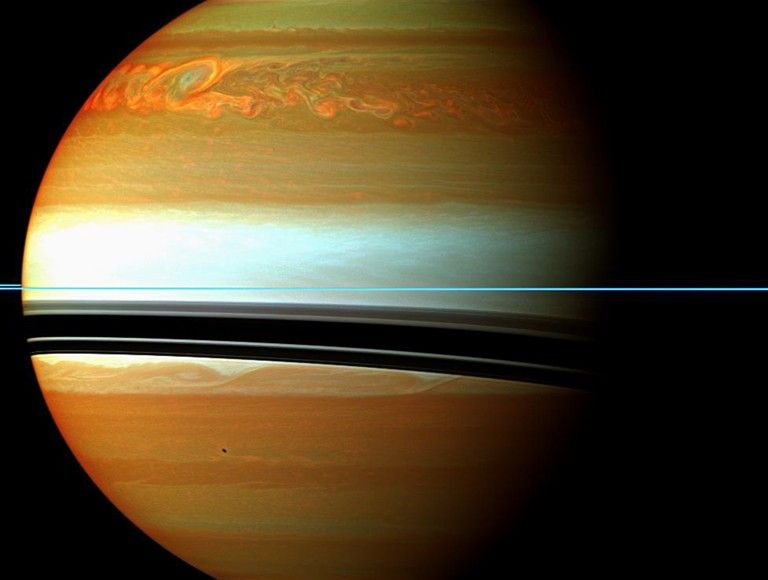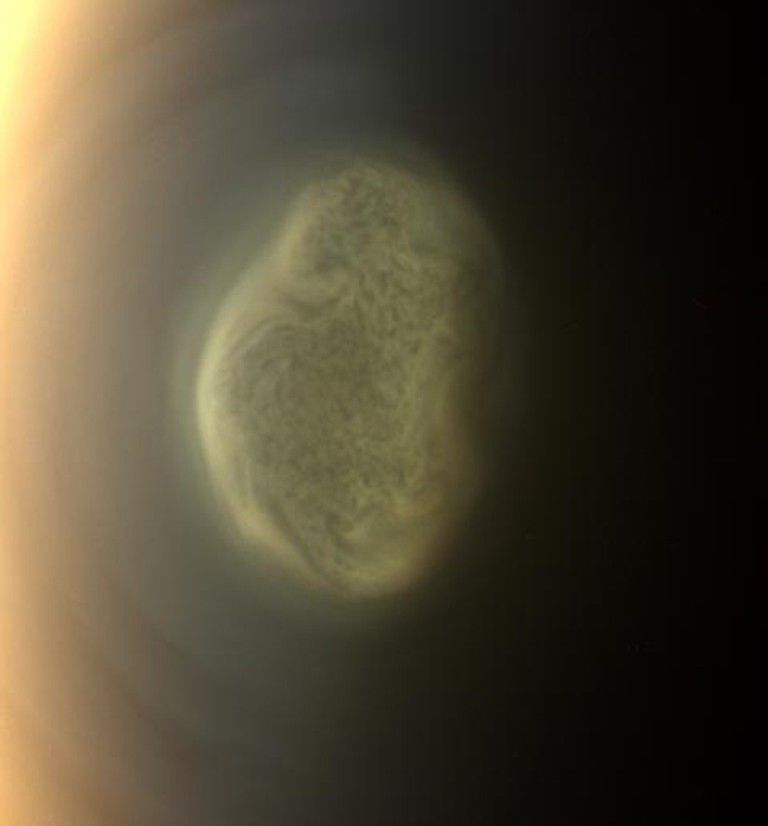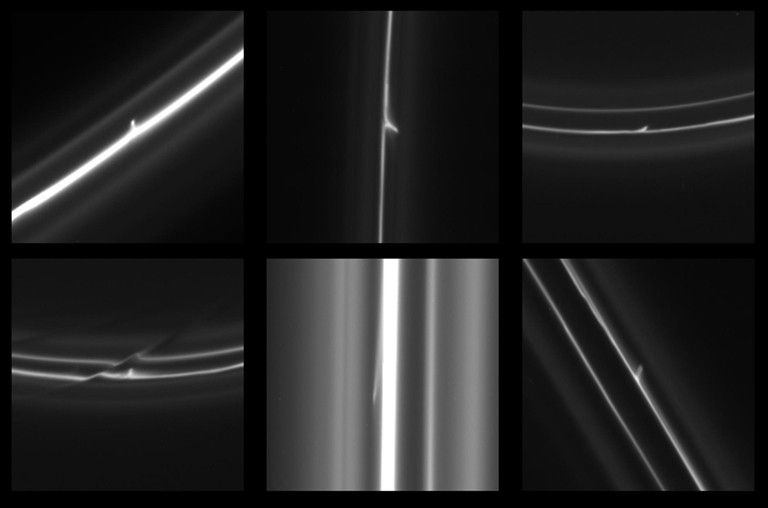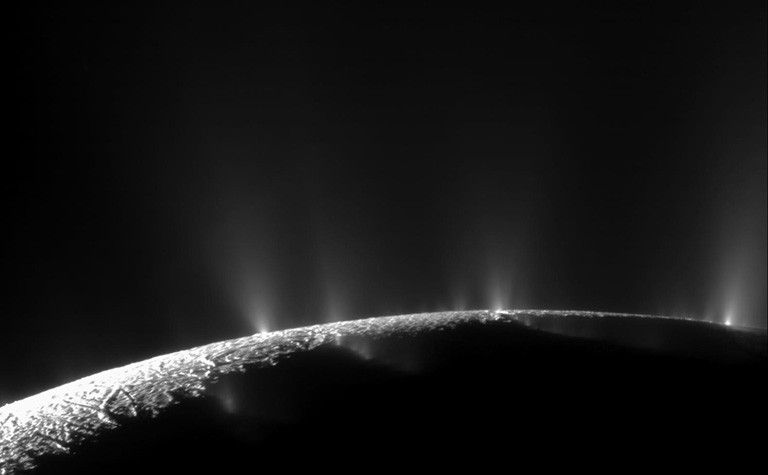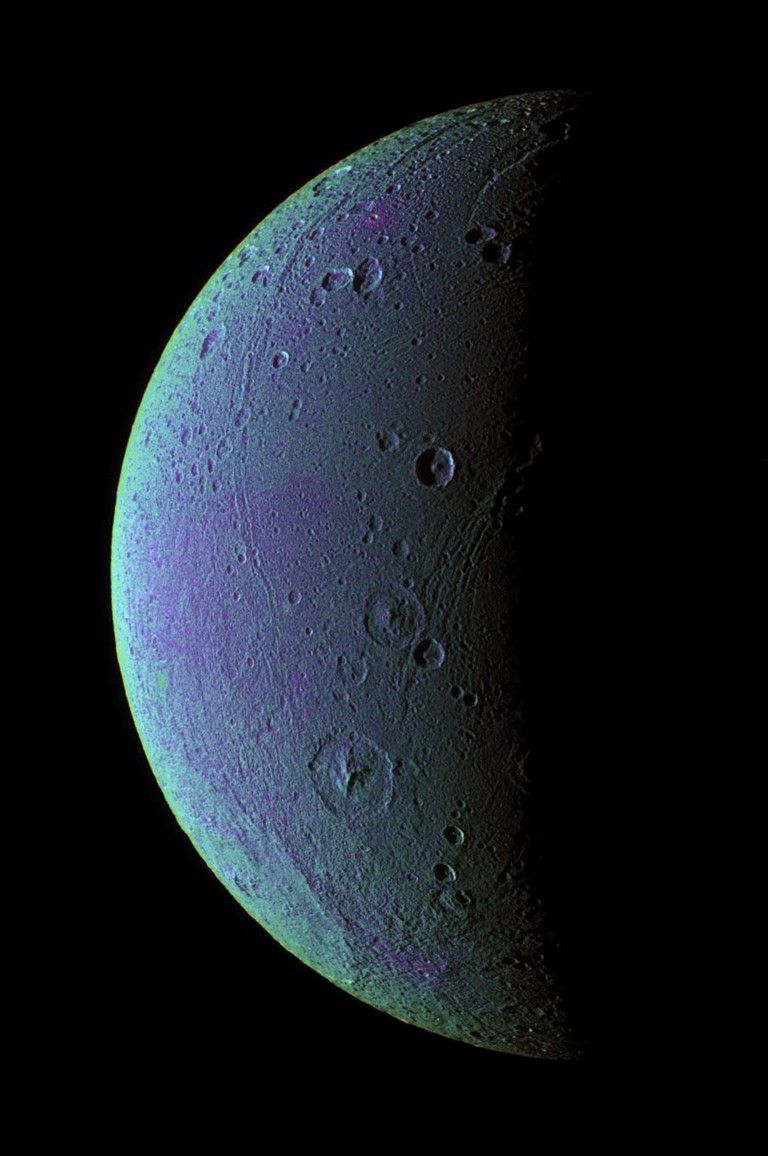Cassini Top 10 Science Highlights – 2012
The scientific discoveries made possible by the Cassini spacecraft at Saturn keep coming in at an astounding pace. How many layers does this solar-system-in-miniature have to unveil? As the data arrives, scientists the world over are digging deeper into the mysteries of the Saturnian system. Chosen by scientists on the Cassini mission, these 10 science highlights stood out in 2012.
- Titan Subsurface Ocean
- Saturn Burps and Beacons
- Titan’s South Polar Vortex
- Another Pac-Man Found!
- Glittering Trails in Saturn’s F Ring
- Dusty Plasma From Enceladus
- Saturn Daytime Lightning
- Methone: New Observation of Small Moons
- Predators and Prey, the Ecology of Saturn’s Ring Particles
- Fresh Air at Dione
1. Titan Subsurface Ocean
- Based on a large amount of squeezing and stretching as the moon orbited Saturn, scientists deduced that if Titan were composed entirely of stiff rock, the gravitational attraction of Saturn would cause bulges, or solid "tides," on the moon only three feet (one meter) in height. Spacecraft data show Saturn creates solid tides approximately 30 feet (10 meters) in height, which suggests Titan is not made entirely of solid rocky material.
- Because Titan is not spherical, but slightly elongated like a football, its long axis grew when it was closer to Saturn. Eight days later, when Titan was farther from Saturn, it became less elongated and more nearly round.
- An ocean layer does not have to be huge or deep to create these tides. A liquid layer between the external, deformable shell and a solid mantle would enable Titan to bulge and compress as it orbits Saturn. Because Titan's surface is mostly made of water ice, which is abundant in moons of the outer solar system, scientists infer Titan's ocean is likely mostly liquid water.
Also see:
Cassini Finds Likely Subsurface Ocean on Saturn Moon
2. Saturn Burps and Beacons
- The Composite Infrared Spectrometer (CIRS) tracked the evolution of the vortexes left behind in the stratosphere after the Northern Storm.
- Temperature increases of about 80K (about 144 degrees Fahrenheit or 80 degrees Celsius) have been observed in the stratosphere. Such temperature increases are unprecedented in the solar system.
- Huge abundance increases was also detected for several molecules, including ethylene, in the atmosphere of Saturn. Why some molecular abundances changed drastically, while others did not, remains a mystery.
- This is an excellent example of where the synergy of Cassini data and ground based observations (Celeste at Kitt Peak in this case) can enhance science return.
Also see:
NASA's Cassini Sees Burp at Saturn After Large Storm
3. Titan’s South Polar Vortex
- The structure inside the vortex is reminiscent of the open cellular convection that is often seen over Earth's oceans.
- While the northern hood has remained, the circulation in the upper atmosphere has been moving from the illuminated north pole to the cooling south pole. This movement appears to be causing downwellings over the south pole and the formation of high-altitude haze and a vortex.
Also see:
The Titanian Seasons Turn, Turn, Turn
4. Another Pac-Man Found!
- Scientists with NASA's Cassini mission have spotted a second feature shaped like the 1980s video game icon in the Saturn system, this time on the moon Tethys.
- Scientists theorize that the Pac-Man thermal shape on the Saturnian moons occurs because of the way high-energy electrons bombard low latitudes on the side of the moon that faces forward as it orbits around Saturn.
- The bombardment turns that part of the fluffy surface into hard-packed ice. As a result, the altered surface does not heat as rapidly in the sunshine or cool down as quickly at night as the rest of the surface.
- Because the altered region on Tethys, unlike on Mimas, is also bombarded by icy particles from Enceladus' plumes, it implies the surface alteration is occurring more quickly than its recoating by plume particles.
Also see:
Cassini Finds a Video Gamers' Paradise at Saturn
5. Glittering Trails in Saturn’s F Ring
- These trails in the rings, which scientists are calling "mini-jets," fill in a missing link in our story of the curious behavior of the F ring.
- Scientists have known that relatively large objects like Prometheus (as long as 92 miles, or 148 kilometers, across) can create channels, ripples and snowballs in the F ring, but did not know what happened to these snowballs after they were created.
- Some were surely broken up by collisions or tidal forces in their orbit around Saturn, but now scientists have evidence that some of the smaller ones survive, and their differing orbits mean they go on to strike through the F ring on their own.
- In some cases, the objects traveled in packs, creating mini-jets that looked quite exotic, like the barb of a harpoon. Other new images show grand views of the entire F ring, showing the swirls and eddies that ripple around the ring from all the different kinds of objects moving through and around it.
Also see:
Cassini Sees Objects Blazing Trails in Saturn Ring
6. Dusty Plasma From Enceladus
- Data from Cassini's fields and particles instruments also show that the usual 'heavy' and 'light' species of charged particles in normal plasma are actually reversed near the plume spraying from the moon's south polar region.
- About 200 pounds (about 100 kilograms) of water vapor per second – about as much as an active comet – spray out from long cracks in the south polar region known as "tiger stripes." The ejected matter forms the Enceladus plume – a complex structure of icy grains and neutral gas that is mainly water vapor.
- The grains range continuously in size from small water clusters (a few water molecules) to thousandths of an inch (100 micrometers).
- In this environment, Cassini has now seen positively charged ions become the small, "light" plasma species and the negatively charged grains become the "heavy" component. This is just the opposite of "normal" plasmas, where the negative electrons are thousands of times lighter than the positive ions.
- In a dusty plasma, conditions are just right for the dust to also participate in the plasma's collective behavior. This increases the complexity of the plasma, changes its properties and produces totally new collective behavior. Dusty plasma are thought to exist in comet tails and dust rings around the sun.
Also see:
Enceladus Plume is a new Kind of Plasma Laboratory
7. Saturn Daytime Lightning
- Cassini has captured images of last year’s storm on Saturn, the largest storm seen up-close at the planet, with bluish spots in the middle of swirling clouds. Those bluish spots indicate flashes of lightning and mark the first time scientists have detected lightning in visible wavelengths on the side of Saturn illuminated by the sun.
- The lightning flashes appear brightest in the blue filter of Cassini’s imaging camera on March 6, 2011. Scientists aggressively heightened the blue tint of the image to determine its size and location. Scientists are still analyzing why the blue filter catches the lightning. It might be that the lightning really is blue, or it might be that the short exposure of the camera in the blue filter makes the short-lived lightning easier to see.
- The intensity of the flash is comparable to the strongest flashes on Earth. The visible energy alone is estimated to be about three billion watts lasting for one second. The flash is approximately 100 miles (200 kilometers) in diameter when it exits the tops of the clouds. From this, scientists deduce that the lightning bolts originate in the clouds deeper down in Saturn’s atmosphere where water droplets freeze. This is analogous to where lightning is created in Earth’s atmosphere.
Also see:
Cassini Spots Daytime Lightning on Saturn
8. Methone: New Observation of Small Moons
- The flyby of Methone took place on May 20 at a distance of about 1,200 miles (1,900 kilometers). It was Cassini's closest flyby of the two-mile-wide (three-kilometer-wide) moon. The best previous Cassini images were taken on June 8, 2005, at a distance of about 140,000 miles (225,000 kilometers), and they barely resolved this object.
- Cassini discovered Methone and two other small moons, Pallene and Anthe, between the orbits of Mimas and Enceladus between 2004 and 2007. The three tiny moons, called the Alkyonides group, are embedded in Saturn's E ring, and their surfaces are sprayed by ice particles originating from the jets of water ice, water vapor and organic compounds emanating from the south polar area of Enceladus.
Also see:
Cassini Spots Tiny Moon, Begins to Tilt Orbit
9. Predators and Prey, the Ecology of Saturn’s Ring Particles
- The imaging team’s studies of propeller-shaped gaps has restarted with the return to inclined orbits by Cassini.
- These gaps are cleared out by objects that are smaller than known moons but larger than typical ring particles. Cassini scientists haven’t seen propellers in two years.
- Because some of the propellers are exactly where models predicted they would be, scientists believe they are seeing some old friends again.
Also see:
Saturn's Rings are Back
10. Fresh Air at Dione
- Cassini spacecraft has “sniffed” molecular oxygen ions around Saturn’s icy moon Dione for the first time, confirming the presence of a very tenuous atmosphere.
- The oxygen ions are quite sparse – one for every 0.67 cubic inches of space (one for every 11 cubic centimeters of space) or about 2,550 per cubic foot (90,000 per cubic meter) – showing that Dione has an extremely thin neutral atmosphere.
- Oxygen appears to derive from either solar photons or energetic particles from space bombarding the moon’s water ice surface and liberating oxygen molecules. However, scientists will be looking for other processes, including geological ones, that could also explain the oxygen.
- Several solid solar system bodies – including Earth, Venus, Mars and Saturn’s largest moon Titan – have atmospheres. But they tend to be typically much denser than what has been found around Dione. However, Cassini scientists did detect a thin exosphere around Saturn’s moon Rhea in 2010, very similar to Dione. The density of oxygen at the surfaces of Dione and Rhea is around 5 trillion times less dense than that at Earth’s surface.


























